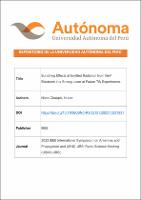| dc.contributor.author | Nieto-Chaupis, Huber | |
| dc.date.accessioned | 2023-12-28T14:43:31Z | |
| dc.date.available | 2023-12-28T14:43:31Z | |
| dc.date.issued | 2023 | |
| dc.identifier.uri | https://hdl.handle.net/20.500.13067/2924 | |
| dc.description.abstract | Future experiments that consider the collision of GeV electrons and TW laser have as central objective to probe non-perturbative QED at the strong field where processes derived from Schwinger critic field can be observed. Nevertheless, the huge photon density will allow to electron to absorb and emit various photons as creating a bunching of them, fact that might be an obstacle to observe a clean signal. In this paper, with basic principles of classical electrodynamics, the radiated intensity is numerically estimated. Unclear nonlinear final states emerge as potential background to reduce signal efficiency drastically. | es_PE |
| dc.format | application/pdf | es_PE |
| dc.language.iso | eng | es_PE |
| dc.publisher | IEEE | es_PE |
| dc.rights | info:eu-repo/semantics/restrictedAccess | es_PE |
| dc.rights.uri | https://creativecommons.org/licenses/by-nc-nd/4.0/ | es_PE |
| dc.subject | Electrodynamics | es_PE |
| dc.subject | Electric potential | es_PE |
| dc.subject | Conferences | es_PE |
| dc.subject | Lasers | es_PE |
| dc.subject | Sociology | es_PE |
| dc.subject | Mathematical models | es_PE |
| dc.subject | Statistics | es_PE |
| dc.title | Bunching Effects at Emitted Radiation from GeV Electrons in a Strong Laser at Future TW Experiments | es_PE |
| dc.type | info:eu-repo/semantics/article | es_PE |
| dc.identifier.journal | 2023 IEEE International Symposium on Antennas and Propagation and USNC-URSI Radio Science Meeting (USNC-URSI) | es_PE |
| dc.identifier.doi | https://doi.org/10.1109/USNC-URSI52151.2023.10237931 | |
| dc.subject.ocde | https://purl.org/pe-repo/ocde/ford#2.02.04 | es_PE |
| dc.relation.url | https://ieeexplore.ieee.org/document/10237931 | es_PE |


